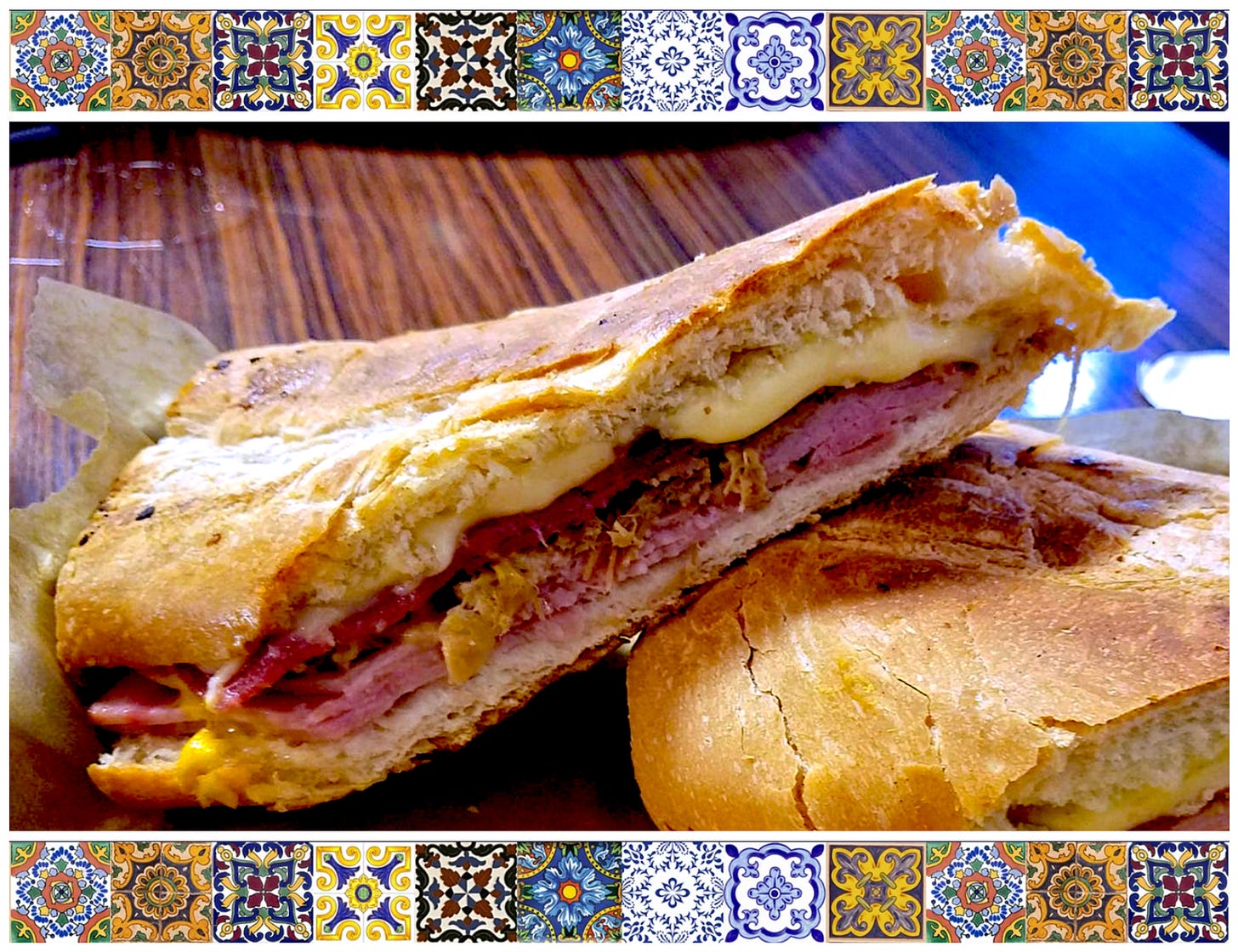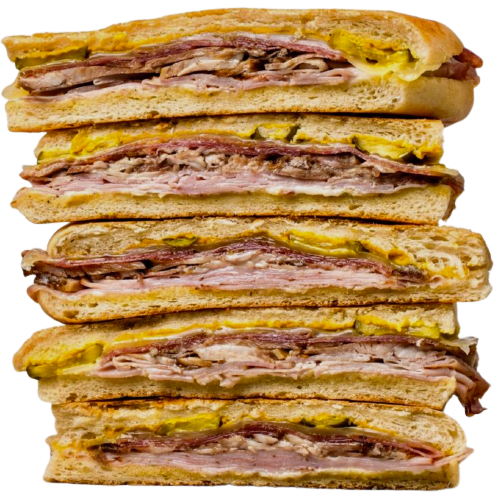Welcome back to Notable Sandwiches, the series in which I, alongside my editor David Swanson, stumble through the strange and ever-shifting document that is Wikipedia’s List of Notable Sandwiches, in alphabetical order. This week: David on the Cuban sandwich.
— Talia Lavin
“Do you wish me a good morning, or mean that it is a good morning whether I want it or not; or that you feel good this morning; or that it is a morning to be good on?”
— Gandalf, The Hobbit
Semantics can be a tricky thing, as I learned when I set out to discover who invented the Cuban sandwich. Because, well, what is a Cuban sandwich, really, you know? “We see now through a glass darkly, and the truth, before it is revealed to all, we see in fragments (alas, how illegible) in the error of the world,” writes Adso of Melk, the pious narrator of Umberto Eco’s The Name of the Rose, “so we must spell out its faithful signals even when they seem obscure to us.” Like Adso, I find myself perplexed with semantics, with semiotics, with etymology. My struggle this week hasn’t been quite so existential as his, but in trying to take on a different narrative of a name—one whose truths are fragmented across seas and time—I may have bitten off more than I can chew.
Indeed, the provenance, genesis and ownership rights of the “Cuban sandwich” have set off one of the more contentious debates in all of sandwich-dom (where contentious debates are legion.) The name, of course, would suggest that the Pearl of the Antilles herself can rightfully lay claim to her namesake sandwich. But Florida—particularly Miami and Tampa Bay—have their own claims to stake, and those claims are uncompromising. What makes a sandwich Cuban, anyway? Is it Cuba or is it Cubans?
El Cubano as we know it today is a sandwich bound by a fairly rigid set of guidelines. An emblematic version that you might find in, say, Little Havana, Miami, would typically include sliced ham, roast pork, Swiss cheese, sour pickles, and yellow mustard on buttered crusty Cuban bread—pan de agua—with the whole thing pressed in a hot plancha until it coheres into a glorious gooey plank. At a similar spot 200 miles northwest, in Ybor City, Tampa, the sandwich’s composition would be roughly the same, with the crucial addition of salami.
The Sword and the Sandwich is a newsletter about serious extremism and equally serious sandwiches. Please consider supporting this work with a paid subscription:
I personally ascribe to the Tampa version, which I was introduced to while working in midtown Manhattan two decades ago. I can’t say when exactly a benevolent coworker first brought me to the magical Margon, a well-worn Latin luncheonette just off Times Square, but it stayed firmly fixed in my weekly midday routine for the fifteen years I worked within walking distance. That’s still the go-to Cubano for me, though the presence of salami isn’t a sine qua non. A far more meaty question than that of salami is how, precisely, to parse the etymology of the sandwich.
If we define a “Cuban sandwich” as fundamentally “a sandwich from Cuba,” then Havana wins this round. But even back when the city was a true hotbed of the sandwich arts, you’d have had as hard a time finding a “Cuban Sandwich” on a menu there as you would “French Toast” at a Paris bistro or a Sicilian slice at a Palermo pizzeria. You don’t have to identify your own reflection in a mirror; you can’t get “Belgian frites” in Bruges. Cuba was indeed renowned for its sandwiches, as far back as the nineteenth century. But they were known as “mixtos”(“mixed”) and sound more like what Americans know as a sub, hoagie, or hero than the hot-pressed delight we call a Cubano in 2023.
As the authors Dr. Bárbara Cruz, Jeff Houck, and Andrew T. Huse recount in their invaluable The Cuban Sandwich: A History in Layers, the ingredients for an Old Havana-style sandwich could include anything from turkey to mortadella to paté to tuna. In an article in the Brooklyn Eagle from 1900, a “Cuban sandwich” was said to resemble a club sandwich: “On the bottom slice of bread is placed a layer of the white meat of cold chicken sliced very thin, then wafer-like slices of cold boiled ham topped with thin slices of cucumber pickles, shavings of bologna sausage and over all slices of cheese.” Ham, sausage, roast pork, cheese, pickles and mustard were all typical ingredients, but the result wasn’t pressed. This is the sandwich—notable for its size and the wide variety of possible ingredients if not for its temperature—that became widely known in the United States as a “Cuban.” Does a mixto by any other name taste as savory?
(Side note: It should come as little surprise that, in the wake of the Bay of Pigs debacle and the Cuban Missile Crisis, certain jingoistic establishments in the United States renamed the Cuban sandwich “the Caribbean” and “the Latin American,” among other less Castro-friendly monikers. Freedom fries, eat your heart out.)
Geography and casual appellation, however, don’t take us to the end of this saga. Some purported authorities on the internet take the story back much further, claiming that the Cuban sandwich first appeared over 500 years ago, when the native Taíno people ate fish or bird meat in an ersatz breadstuff made from mashed yucca root. Does that sound like a Cuban sandwich to you? This smacks of orphan fact-peddling and sandwich apologetics (although the Taíno did invent barbecue.)
So much for geography. We move on to the other potential criteria. If you consider the ingredients to be the defining characteristic of a sandwich, Tampa Bay’s claim is strong—so strong that the city threw down the mustard-smeared gauntlet with a resolution declaring the “Historic Tampa Cuban Sandwich” as the city’s “signature sandwich” in 2012. At that point the sandwich been a regional favorite for over a century. By the late 1800s, the area was already home to a burgeoning Cuban community, lured to the area by a fledgling cigar manufacturing industry based in Ybor City. At eateries catering to the local tobacco workers, mixtos were a popular staple, and the familiar profile of the sandwich began to come into focus.

Ybor City’s Columbia Restaurant—the oldest eatery in all of Florida—first opened its doors in 1905, and still sells a version of the Cuban sandwich that they introduced to their menu in 1915. This offering was long identified as a mixto, but the ingredients are familiar: house-prepared glazed ham, marinated roast pork, peppercorn-studded Genoa salami, Swiss cheese, two strips of dill pickle, and a smear of French’s yellow mustard, all layered between a portion of light and crusty bread fresh from La Segunda bakery, made with a palmetto leaf laid along the top of each loaf. For decades the sandwiches were heated up in the oven before serving, to provide the proper melting and melding of flavors and textures, but it wasn’t until the 1950s that they started using a sizzling flat-top plancha to press their sandwiches.
Which brings us to the third criterion, as we work to assemble the fragments of truth. Is it the method that makes the sandwich—the tools of its assembly? According to The Cuban Sandwich: A History in Layers, sandwich makers had long been using tailor’s presses or hand-irons to flatten and toast their wares, but it was in Miami’s Little Havana that the plancha became an integral component of Cuban sandwich construction. Perhaps even the most central, defining component. And if you subscribe to that idea, well, then Miami may have an even better claim to the sandwich than Havana or Tampa.
It was also through Miami version that many Americans first learned about the sandwich, when Jon Favreau gave it a Hollywood closeup with the release of Chef in 2014. The actor-director became addicted to Cubanos while filming the Iron Man franchise in Little Havana, and proceeded to don the mantle of sandwich evangelist. In one memorable scene he prepares sandwiches with his son and John Leguizamo, his right-hand man. “Now, this is the most important part,” says Favreau, as he places a freshly assembled sandwich in the sizzling plancha. “This is what makes it a Cubano.”
If Favreau is right, and the plancha is indeed the key component—if pressing the sandwich is the crucial step—then Miami’s claim is hard to argue with. Due to the vagaries of climate, Tampa’s bread was crisp on its own, but in Miami they needed help to give the pan de agua its signature crust. So, necessity being the mother of invention, the custom sandwich press was introduced to the world of the Cubano, and the sandwich achieved the form we know today. “The plancha really became standard starting in the mid-fifties, because it helped the Miami sandwich replicate the Tampa version,” says Jeff Houck. “And then, as the Cuban population increased after the Revolution, that version became more and more ubiquitous.”
“But the thing that made the Cuban sandwich popular wasn’t the name or the origin, it was the combination of salty, sweet, crunchy, pickle-y, mustard-y flavors,” says Houck. “It was the flavors that make the sandwich great.” As extensive—and occasionally tasty—as my research has been, I do not claim authority on the sandwich. For that I direct you to Houck and his team, who literally wrote the book on the subject. All I can know, through the evidence of my senses and my all-too-fallible faculties of understanding, is that the combination of bread, pork, mustard, pickle and Swiss, plancha-pressed, is a slice of earthly bliss.
In the end, perhaps the Cubano is a child with three mothers. Havana birthed the sandwich, Tampa raised and refined it, Miami perfected it and sent it out into the world. No wonder it’s the subject of a three-way geographical squabble—one that we have gestured towards resolving, but whose ultimate truth can only be resolved in that sacred realm where all knowledge is absolute. Or I shall leave it to you: to quote Adso of Melk again, sometimes the task of the narrator is “to leave to those who will come after (if the Antichrist has not come first) a signs of signs, so that the prayer of deciphering may be exercised on them.” Amen.








I know that Tortas are much further down the wikipedia list & won't be gotten to for a while, but this piece on The Cuban brings the Torta Cubana to mind. It's not a Cuban, it's not *just* a Torta, it's its own glorious thing that'll make a sandwich lover's soul leap for joy.
They vary a bit, but it's usually some combination of Milanesa (breaded cutlet), pork loin, ham, maybe some turkey, sliced hot dogs, chorizo, tomato, avocado, onion, peppers, one or two or three kinds of melted cheese, probably some condiments of some sort, all on a bolillo roll as big as your head. Lots of little Mexican restaurants make a version. If you've never had one yet and you encounter one on a restaurant menu, remember that one of your fans recommends these highly.